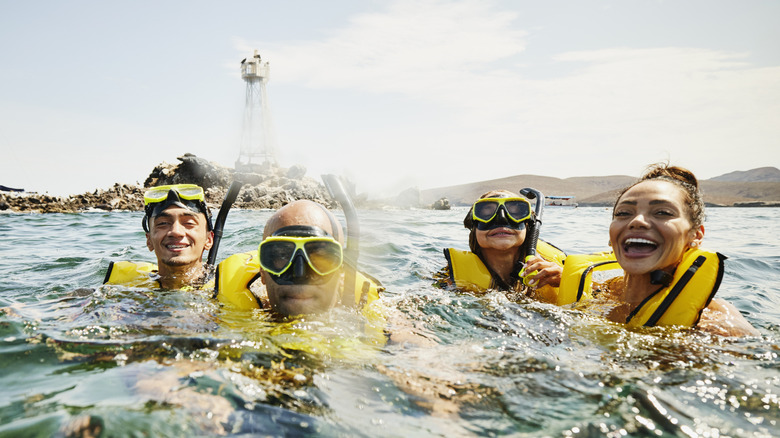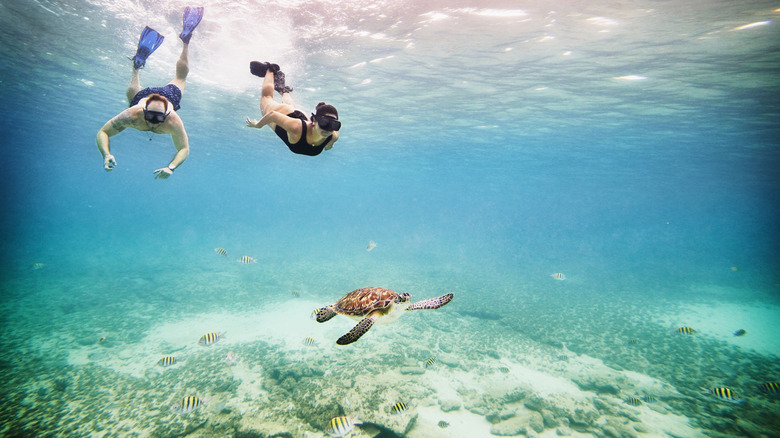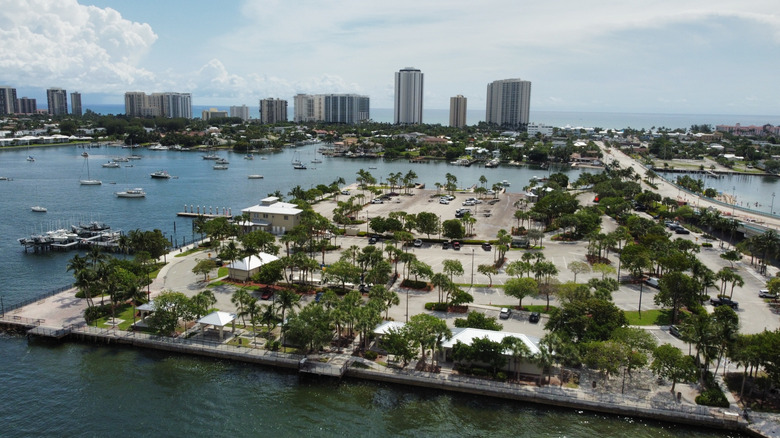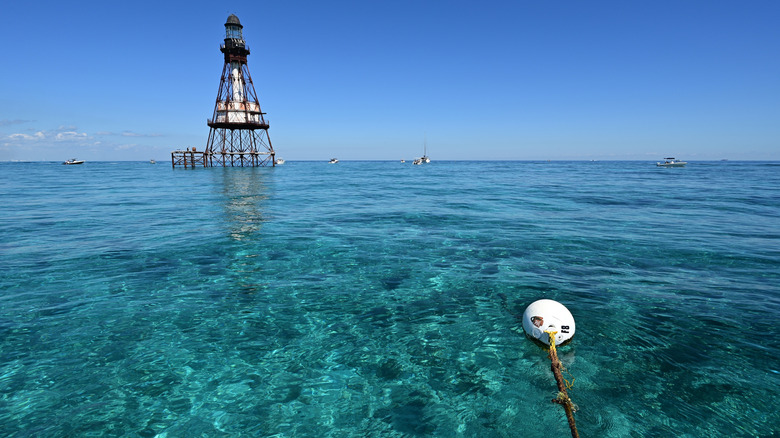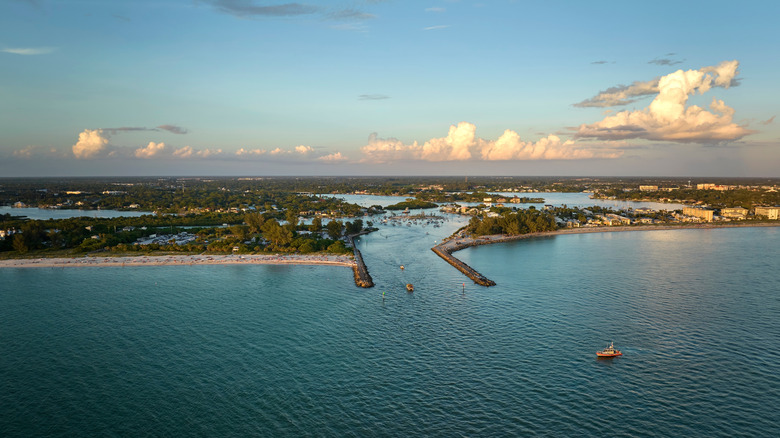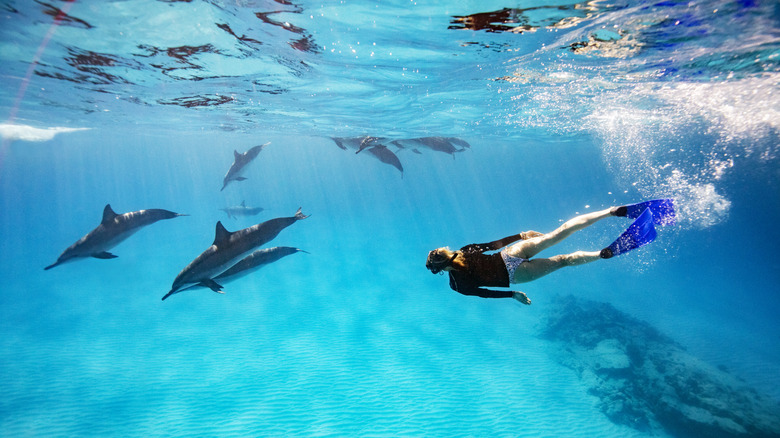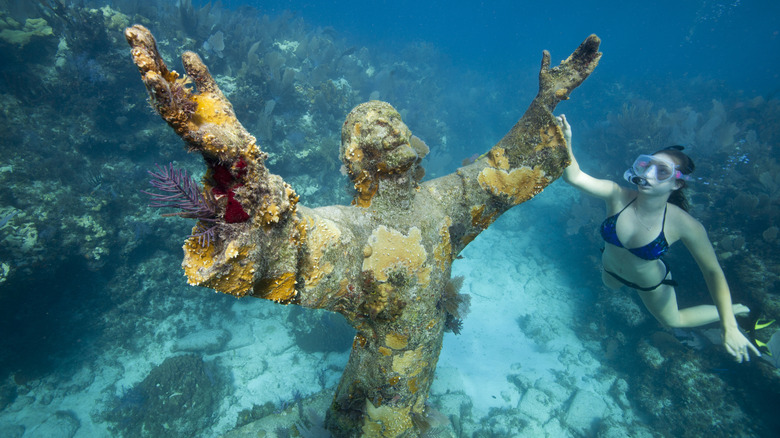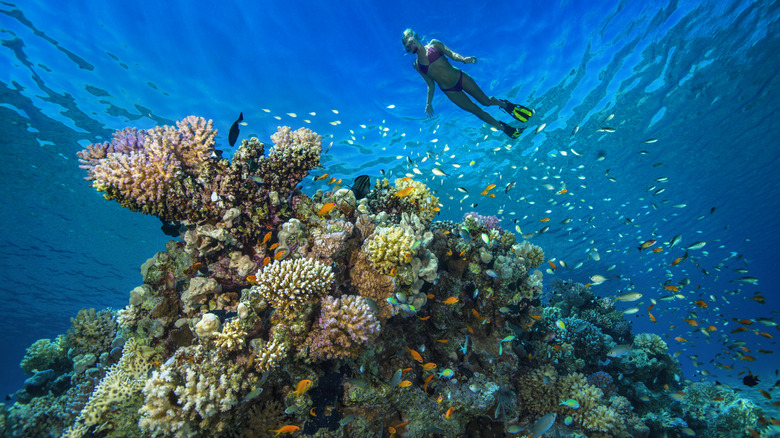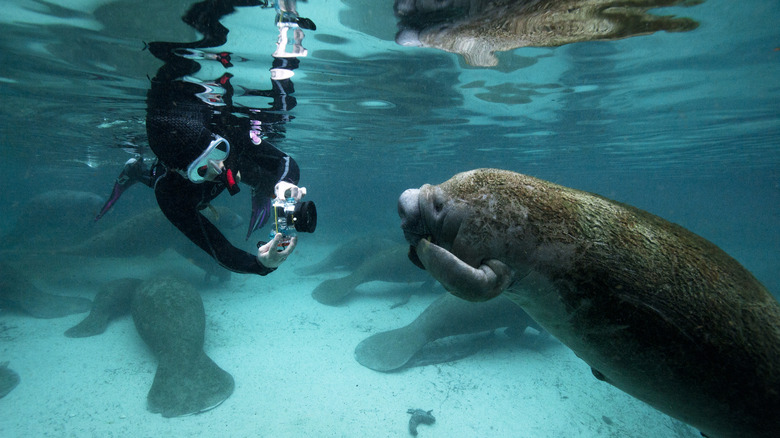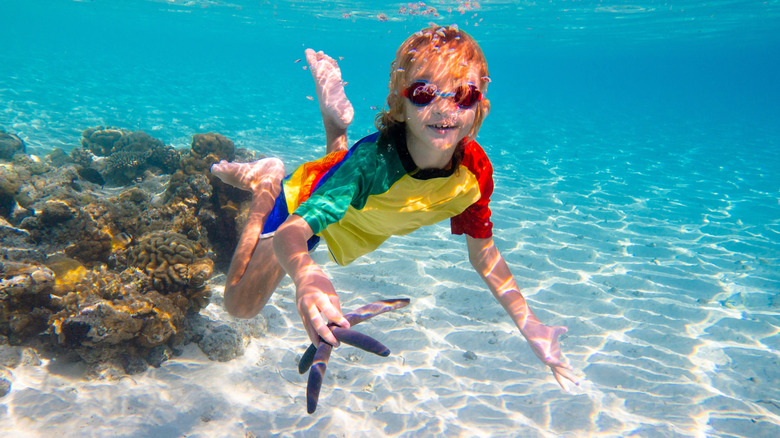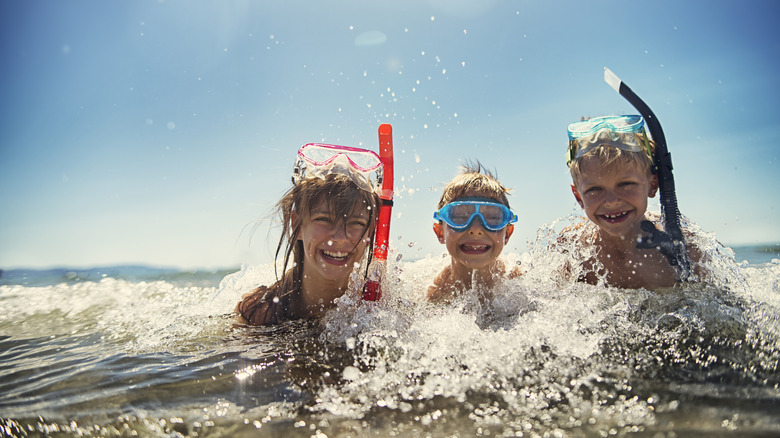The Absolute Best Beaches In Florida For Snorkeling, According To Visitors
With summer hot on our heels, it's time to start planning those sand and sea escapades. And for many people in the U.S., the prime destination to enjoy some time in the sun and by the water is the glorious Sunshine State. If you're headed to Florida this year, your travel itinerary might just be calling out for a snorkeling adventure.
Florida is practically a snorkeling paradise, with crystal-clear waters, rich coral reefs, and curious sea creatures like manatees and seahorses ready to put on a show. But with hundreds of miles of coastline, it can be difficult to pin down the exact location you want to dive in. Should you head to Key West or the Panhandle, the Atlantic Ocean or the Gulf of Mexico (also known as the Gulf of America)? Each region offers something different.
To help ease your travel planning process, we've scoured the rankings of snorkeling experts and official wildlife outlets to uncover the top snorkeling beaches in the Sunshine State so no matter where you drop your pin, you can trust that you will have an unforgettable experience swimming alongside sea turtles, eels, sharks, stingrays, and more. So grab your mask and fins — these are the most spectacular destinations across Florida for a summer snorkeling adventure.
Dry Tortugas National Park
For one of the best snorkeling spots in Florida, head to Key West and then keep going west. That's right, Dry Tortugas National Park is on the very outskirts of this tiny Florida island city, and it is so remote that this national park is only reachable via boat or seaplane. Once you've arrived, you and your crew will be treated to palm-tree-dotted views and the impressive Fort Jefferson. Considered the largest all-masonry fort in the whole country, it was built in the mid-1800s and played a crucial role in the Civil War.
But the real show begins once you've got your snorkeling gear sorted. Under the water, you can explore the Florida Keys reef system, which is, if you can believe it, the third largest in the world — and we have it right here on our American doorstep! The biggest marine treat you'll find here is encounters with sea turtles. Five species of sea turtle frequent the waters surrounding Dry Tortugas National Park: Loggerhead, green turtle, leatherback, Kemp's ridley, and hawksbill.
In fact, that's how the location got its name; "tortugas" is the Spanish word for "turtles." In addition to these beautiful shelled creatures, you will also be able to experience up-close encounters with fire coral, jellyfish, sea urchins, and more, including the exotic venomous lionfish! Don't worry, though; if you keep your distance, these venomous aquatic wonders will keep their distance as well.
Bathtub Reef Beach
If you're traveling with little ones, this snorkeling spot located near Stuart is the ideal place in Florida to introduce your children to the marvels of marine life. When snorkeling for the first time, the depth of the dive can be a bit scary, the breathing apparatus can be difficult to manage, and some of the sea creatures might even be a bit spooky. However, the calm and warm waters of Bathtub Reef Beach will help ease even the youngest snorkelers into the sport. There will be no harsh splash of cold Atlantic water, as this spot got its name for having waves as warm as gentle bath water.
And just a few miles away from the shore, you'll find a rich reef system that over 500 sea creatures call their home. Expect endangered sea turtles to swim on by, as well as the architects of the reef itself: mini creatures called Sabellariid sea worms. Not only will the variety of species astound snorkelers of all ages, but you can also be assured that you and your children will come to the surface having learned more about our delicate oceans.
Even better? In 2025, Martin County officials revealed a remodeled Bathtub Beach. New sand dunes and sea oats mean that this spot is not only perfect for snorkeling, but it is also now scenic and safe for families to set up camp on the shore and make castles to their hearts' content on the newly-implanted 35,000 cubic yards of sand.
Phil Foster Park
Snorkel one of the most resilient coral reefs in the state of Florida at Phil Foster Park. Located in Riviera Beach and home to the Blue Heron Bridge, this unique beach location is home to some rare wildlife, such as seahorses, octopus, pipefish, frogfish, batfish, nudibranchs, and more. It's a delicate ecosystem, but thanks to dedicated diving teams and underwater aficionados, it has become one of the premier snorkeling spots in the nation.
If you snorkel closer to the bridge itself, you might even be lucky enough to catch a glimpse of the majestic manatee that has become something of a mascot for the Sunshine State. Other potential encounters include meeting spotted eagle rays, manta rays, nurse sharks, green sea turtles, or a goliath grouper. Many snorkeling guides not only offer their expertise in the marine wildlife of the Riviera Beach area but are also open to training and educating complete beginners on the basics of snorkeling. Prep gear, sunscreen, towels, and even post-adventure snacks are readily available.
Looking for something especially thrilling? Phil Foster Park also allows night diving. While a permit is required, the Force-E's FREE Blue Heron Bridge night dives occur every two weeks, and if you time it right, you just might be able to take part in the otherworldly experience of seeing what these unique creatures look like under the moonlit sky (or should we say sea?)
Biscayne National Park
Stop off on your trip to Miami at Biscayne National Park, a snorkeling playground where you can ditch the neon lights of South Beach and experience a more tranquil side to southern Florida. Fanning out across 172,900 acres, this cerulean gem is categorized as a subtropical wetland park, encompassing coral reefs and barrier islands. Safely snorkel around coral reefs and be astounded at the lively little creatures that live within, while also keeping an eye out for some rarer objects.
With a history that dates back at least 10,000 years, the waters of Biscayne Bay evidence of prehistoric tribes and centuries-old shipwrecks as well as interesting marine life. This is the perfect spot for the history-obsessed traveler. Partake in the Biscayne Maritime Heritage Trail, an underwater snorkeling adventure where guides take you to six of the most interesting shipwreck sites in the Biscayne area.
Explore the remains of the Keel Showing Wreck, a wooden vessel of unknown origins that is believed to date back to the 1800s. Or perhaps the Arratoon Apcar, a Scottish merchant ship that crashed on the Fowey Rocks in February of 1878. Of course, for something a bit more nature-focused, snorkeling trips to the colorful coral reefs are also available. Over 500 species of reef fish call the Biscayne National Park their home, meaning that you can traverse the waters right alongside creatures with some of the most fascinating names, from blue neon gobies to yellow striped porkfish, parrotfish, and more.
Venice Beach
If you're looking for a heat-rate-rising snorkeling quest, where else better to go than the "Shark Tooth Capital of the World?" Venice Beach (as it's called on maps) is the place to go to ensure you take home a souvenir or two. Travel just a quarter-mile offshore, and you'll find a beautiful coral reef and tiny fossilized shark teeth waiting to be made your favorite new accessory.
Don't worry, as these mint-green waters only house the remains of ancient sharks. Millions of years ago, the land mass that we know as Florida was an underwater island. As the coastline slowly receded, hundreds of prehistoric sharks began to die out. You won't find any fully intact shark skeletons, their preserved teeth have been pushed inland by years of storms, finding their home in the shallow (and snorkelable) waters of Venice Beach.
If you time your vacation just right, you may even be able to attend the Shark Tooth Festival that springs up every year, celebrating Venice Beach culture, and providing you and your fellow snorkelers a chance to hunt through the collection of experienced fossil hunters that sell their wares at the festival — that is, only after you enjoy the Florida citrus-inspired food and drink on offer.
St. Andrews State Park Jetty
Florida's Panama City Beach has a hidden gem that most travelers miss. Located in the Panhandle area of the state, St. Andrews State Park will prove to divers, swimmers, and snorkelers alike why this area has been dubbed the "Emerald Coast." Snorkeling in the jetty located to the north of the state park (in particular) is an unmissable experience. These distinctive waters are not the Gulf or the Atlantic Ocean. Instead, they make up a beautiful lagoon formed by a rock jetty. Made up of gentle waters and surrounded by sugar-white beaches, this artificial lagoon is the perfect spot for beginner snorkelers or travelers who are bringing their kids along for the ride.
Although it is considered an artificial reef, that doesn't mean that this lagoon dive is without its fair share of interesting marine life. Strap on your fins and mask and get ready to see a rich collection of rays, angelfish, redfish, sheepshead, octopus, and more. If you're lucky, you might even catch a glimpse of a friendly dolphin playing in the distance. The soft, sandy bottom and excellent visibility make it easy to explore, while the surrounding beach and picnic areas provide the perfect post-snorkel relaxation spot.
John Pennekamp Coral Reef State Park
Snorkeling at John Pennekamp Coral Reef State Park is like stepping (or, rather, swimming) into a real-life tropical postcard. As the first undersea park in the U.S., this Key Largo gem is a unique piece of national history in addition to being home to some of the most vibrant and diverse coral reefs in the Sunshine State. With crystal-clear waters and interesting architecture lurking just beneath the surface, it's no wonder snorkelers flock here every summer.
Glide over stunning sponges and mangrove oysters, weave through schools of dazzling tropical fish, and keep an eye out for graceful sea turtles and even the occasional manatee. One of the park's biggest highlights? The famous Christ of the Abyss statue. Lowered into the lapping water on August 25, 1965, this 9-foot-tall bronze figure is a recast of the original Christ of the Abyss statue, located in the Mediterranean Sea just off the coast of the Italian Riviera. Representing cross-continental connections, the worshipful figure stands as a memorial for all who have lost their lives at sea.
Beginners and expert snorkelers alike can make the pilgrimage to pay their respects to this figure and take in the awe-inspiring sight of this artistic feat slowly being taken over by schools of fish and colorful sprigs of marine plant life. And with a wheelchair-accessible snorkeling ship called The Encounter, John Pennekamp Coral Reef State Park really is committed to making its wonders available to everyone.
Regina Sugar Barge
Looking for an up-and-coming snorkeling hotspot? Look no further than the Regina Sugar Barge, sometimes also called the Molasses Barge. This hidden gem near Bradenton Beach has quickly been gaining traction with snorkeling experts and curious travelers alike. Unlike other snorkeling sites in the Sunshine State, which attract visitors thanks to their naturally occurring coral reefs, this unique location (technically considered an underwater archeological preserve) has something a bit flashier up its sleeve.
It's all thanks to the tragically beautiful ship called The Regina. Constructed in Ireland in 1904, its main purpose was to carry molasses between the continents, a trade that was booming in the early twentieth century. However, before The Regina could reach her 40th birthday, the ship was sunk by a raging storm that struck the Gulf in 1940, resulting in waves up to a height of 12 feet. The poor Regina didn't stand a chance, and today, her remains can be found on the bottom of the aptly named Regina Sugar Barge.
Guided snorkeling trips now kick off at 9 a.m. most days, allowing visitors of all skill levels to explore the historic wreckage of this massive molasses barge. If you're more into the marine life side of things, don't worry, as The Regina has also become an artificial reef, attracting schools of fish and colorful marine plant life. So, if you love a mix of history, mystery, and marine life, the cinematic underwater site is your must-visit snorkeling destination.
Coral Cove Park
This vibrant Florida park is not only the perfect spot to encounter tiny, colorful sea life but also the ideal place to get up close and personal with the dreamlike shapes of underwater rocks and coral. Located in Tequesta, diving into this underrated snorkeling spot feels like stumbling upon a hidden treasure chest at the bottom of the ocean.
It doesn't matter which stage you are at in your snorkeling journey, as there's a wide range of diving depths at Coral Cove. Ranging from 2 to 15 feet deep, both beginner and well-versed divers will find this area fun and challenging. For the clearest water, experts advise that you might want to plan your trip for the late spring or summertime, as this is when the highest number of animals come out to play and when the water conditions are at their most glassy.
Once you've got the numbers and dates sorted out, get ready for a crystal-clear snorkeling experience where you can see the likes of parrotfish, angel fish, sea turtles, and even sergeant majors — tiny fish with unique vertical black stripes like a zebra. Be aware that your blood pressure might suffer a bit of a spike if you happen to be snorkeling when a stingray or a nurse shark swims by. But don't let the "Jaws" theme song enter your head, as these sharks (known to populate the shores of Florida) are famous for their gentle character and penchant for staying along the sandy bottoms of coral reefs.
Peanut Island Park
Despite its whimsical name, Peanut Island is not a make-believe splash zone you might find in an amusement park. No, this thriving park is a real snorkeling hub situated near Florida's Riviera Beach. Spanning 80 acres, this tropical park is vast, shallow, and completely doable for all skill levels. For the best snorkel conditions, you'll want to head to the southeast area of the island.
It's here where you'll find rock structures dotting the sea floor, making for a photogenic backdrop for your vacation photos — just be sure to pack your underwater camera! Colorful reef fish like rainbowfish and parrotfish will add that extra dash of magic to your photos, while larger creatures such as eagle rays and even manatees will provide once-in-a-lifetime nature encounters that you'll be telling your friends about for years to come. These gentle marine mammals are famous for gliding in Florida waters from April to October, so if you're dying to have a sea cow encounter, you might want to mark your calendar for this season.
The waters on Peanut Island are generally clear, but to avoid any foggy views, your best bet is to visit during high tide; this is when the cerulean waters will be at their most transparent, allowing you to see all the amazing colors and shapes of the underwater creatures on display. Be sure to keep your distance and be on your best behavior, as every animal — marine or land-dwelling — in Peanut Park is protected.
Dr. Von D. Mizell-Eula Johnson State Park, Dania Beach
You can't get much more south than this; just below Florida's Port Everglades, you'll find this stunning, untouched coastal ecosystem. In fact, Dr. Von D. Mizell-Eula Johnson State Park is the last of its kind in all of Broward County. For the snorkeling purists out there, you'll be pleased to know that there has been little human intervention in this fish metropolis.
With 2.5 miles of coastline to explore, you and your crew will doubtless get bored. Interesting reef fish to see include angelfish, amberjack, triggerfish, grouper, mutton snapper, and more. Kids will also delight in the starfish on display. There are also other creatures, big and small, in this biome. If you're brave enough to continue the animal safari above water, you can visit the park's manatee sanctuary, where you can get a zoomed-in look at these glorious sea cows. And if you plan your trip in line with sea turtle hatching season, you might also be able to venture above water to witness the 10,000 baby turtles that break out of their shells and waddle to the waves every year.
The educational opportunities don't stop there. Dr. Von D. Mizell-Eula Johnson State Park is an important reminder of Florida's history. It was named after one of the state's more important Civil Rights Movement leaders who led "wade-ins" to protest the state's segregated beaches. Today, the state park is available for all to enjoy, explore, and learn from.
Methodology
To find the best snorkeling spots in Florida, we took a deep dive — literally and figuratively — into research, scouring expert marine guides, travel blogs, and firsthand reviews from snorkelers who've explored the Sunshine State's underwater wonders. Our mission? To pinpoint the top spots where crystal-clear waters, vibrant marine life, and excellent snorkeling conditions come together for an unforgettable experience.
We considered key factors like biodiversity, accessibility, water clarity, and overall "wow" factor. Some locations made the cut for their thriving coral reefs, teeming with tropical fish, while others stood out for their gentle sea turtles, playful manatees, or even historic underwater sites. We also factored in seasonal conditions, ensuring that these beaches offer prime snorkeling opportunities, especially in the spring and summer months. Whether you're a seasoned snorkeler or a first-timer looking for a breathtaking aquatic adventure, this list highlights the best spots to explore Florida's underwater world.
